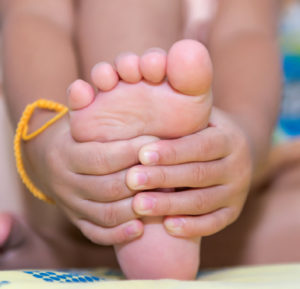 More than 75% of people in the United States will experience foot disorders. Foot pain, like standing on your feet for extended periods, ill-fitting shoes, hereditary and genetic disorders, excessive exercise, trauma, and diseases cause foot problems, and there are a growing number of children with foot conditions.
More than 75% of people in the United States will experience foot disorders. Foot pain, like standing on your feet for extended periods, ill-fitting shoes, hereditary and genetic disorders, excessive exercise, trauma, and diseases cause foot problems, and there are a growing number of children with foot conditions.
Pediatric Foot Pain
Foot and ankle pain is common in children and adolescents. Problems are usually related to skeletal maturity and are relatively specific to the age of the child. Evaluation and management are challenging and requires a thorough history and physical exam and understanding of the pediatric skeleton.
Most foot and ankle pain in the active pediatric population is associated with minor trauma or repetitive stress combined with abnormal biomechanics of the foot and lower extremity. Older children may isolate pain to a specific site, whereas toddlers are more likely to limp or refuse to bear weight. Often there is no clear history of a traumatic event. Numerous, non-traumatic diseases masquerade as injuries.
Ingrown Toenail
An ingrown toenail occurs when the edge of the nail, usually on the big toe, grows into the skin adjacent to it. This causes pain, and if left untreated may result in infection. Signs of an infection include redness, swelling, and discharge at the edge of the toenail. Inflammation may increase to the point where the skin at the edge of the toenail swells over the side of the nail.
Risk factors for an ingrown toenail include:
Abnormal bone anatomy or position of the big toe
Abnormal bone growth beneath the nail
Poor-fitting shoes — too tight at the toes or too loose
Trauma to toe
Heel Pain
Heel pain can be caused by plantar fasciitis, which is an inflamed area of the heel bone where a thick band of tissue called the plantar fascia attaches. This type of heel pain occurs on the bottom of the heel either with activity or after rest. Heel pain in the back of the heel is common in adolescents and may be caused by a condition called Sever’s disease. Sever’s disease is pain along a growth plate at the back of the heel and usually occurs in active children aged 8-14. The pain is caused by strain from the Achilles tendon, which attaches to the back of the heel. One reason children may be susceptible to heel pain is that calf muscles and the Achilles tendon are tight during growth spurts, which puts stress on the heel bone.
Flat Feet
Flat feet are a common condition of the foot structure. In infants and toddlers, prior to walking, the longitudinal arch is not developed, and flat feet are normal. Most feet are flexible, and an arch appears when children begin standing on their toes. The arch continues to develop throughout childhood, and by adulthood, most people have developed normal arches.
Flat feet are generally associated with pronation, a leaning inward of the ankle bones toward the centerline. Shoes of children who pronate, when placed side by side, will lean toward each other (after they have been worn long enough for the foot position to remodel their shape).
Many people with flat feet do not experience pain or other problems. When pain in the foot, ankle, or lower leg does occur, especially in children, the feet should be evaluated.
Painful progressive flatfoot, otherwise known as tibialis posterior tendonitis or adult-acquired flatfoot, refers to inflammation of the tendon of the tibialis posterior. This condition arises when the tendon becomes inflamed, stretched, or torn. Left untreated, it may lead to severe disability and chronic pain. People are predisposed to tibialis posterior tendonitis if they have flat feet or an abnormal attachment of the tendon to the bones in the midfoot.
Nonsteroidal anti-inflammatory medications, icing, physical therapy, supportive taping, bracing, and orthotics are conventional treatments for painful progressive flatfoot. Note: Please consult your physician before taking any medications. In some cases, a surgery may need to be performed to repair a torn or damaged tendon and restore normal function. In the most severe cases, surgery on the midfoot bones may be necessary to treat the associated flatfoot condition.
Mid Florida Foot, Ankle & Vein Clinic provides pain-reducing, comprehensive, cutting-edge treatment. Their podiatrist, Dr. Gabriel Delgado, can treat all foot problems and even performs in-office surgeries. Rest assured you’ll get patient-focused care from their highly skilled and compassionate staff.
To find out more, or to schedule your appointment, please contact Mid Florida Foot, Ankle & Vein Clinic today.
Mid Florida Foot, Ankle & Vein Clinic
Dr. Gabriel F Delgado FACFAS
Lakeland Office
203 Kerneywood St.
Lakeland, FL 33803
Bartow Office
510 West Main St.
Bartow, FL 33830
863-686-1641
midflfootanklevein.com
Check Also
I Have a Wait Problem
You’re reading a health and wellness magazine and you’re thinking: that guy can’t spell. But …
 Central Florida Health and Wellness Magazine Health and Wellness Articles of the Villages
Central Florida Health and Wellness Magazine Health and Wellness Articles of the Villages



